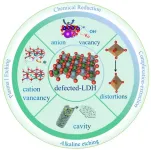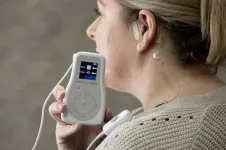(Press-News.org) Pulse oximeters – one of the most common medical devices used in global healthcare – can provide significantly overestimated oxygen saturation readings in people with darker skin tones, according to the most comprehensive study ever to explore the issue.
Published in the British Journal of Anaesthesia, the new study is based on a systematic review of previous research into the use of the devices, and examined 44 studies dating from the mid-1970s to the present day.
In the course of that, researchers assessed more than 733,000 oxygen saturation readings taken from over 222,000 people – including almost 70,000 people of non-white ethnicity.
They found most of the studies revealed evidence of the devices being inclined to overestimate readings in participants with darker skin tones.
While the researchers say it is challenging – based on the current available data – to state the magnitude of those overestimates, they insist it could create a number of issues for both patients and medical professionals.
It could, for example, result in patients not being able to see a doctor as – based on the readings generated by the pulse oximeter – they are deemed to be healthy.
And with studies suggesting the errors are exacerbated at lower levels of oxygen saturation, it could result in patients with critical oxygen levels not receiving treatment which they urgently need.
The new study involved experts in intensive care medicine, dermatology and paediatric care from a number of leading universities and hospitals around the UK.
Professor Daniel Martin OBE, Professor of Perioperative and Intensive Care Medicine in the University of Plymouth and a consultant at the University Hospitals Plymouth NHS Trust (UHP), is the study’s lead author.
He said: “As clinicians, we rely on accurate data to make informed clinical decisions. But during the COVID pandemic, and to some extent since, it was necessary to put thresholds in place which meant that people were only admitted to hospital if their levels fell to a certain point. If those levels are being overestimated – so, for example, if a device is telling someone their oxygen saturation is 98% whereas it is in fact significantly lower – it could realistically mean people are missing out on treatments they need."
When pulse oximeters were introduced around 50 years ago, they were intended solely for use in hospitals and a handful of other healthcare settings.
Today, they are used in everything from GP surgeries to outpatient departments, emergency rooms and intensive care units all over the world, where they are used to monitor the health of people which virtually every form of medical condition.
Crucially, they are also available for the public to purchase in shops, pharmacies and online and many are encouraged to take regular measurements of their oxygen saturation levels in the course of managing a range of health conditions.
Professor Martin said: “If people are admitted to hospital, there are other safety mechanisms to help identify unwell patients. Blood tests to measure oxygen levels, for example, will not be impacted in any way by a person’s skin tone and a medical appointment will allow a doctor or nurse to carry out a physical assessment as well as other types of monitoring. The concern is that there may be people in the community relying on pulse oximeter readings to signify a deterioration in their health, where these additional tests are unavailable.”
Study co-author Professor Eugene Healy, Professor of Dermatology at the University of Southampton and honorary consultant in University Hospital Southampton NHS Foundation Trust, said: “This systematic review highlights the need for clinicians to take account of a person’s skin tone as part of the clinical decision-making process when using pulse oximeters to estimate oxygen levels.”
The findings revealed through the systematic review are already being explored in much greater detail through the EXAKT study, funded by the National Institute for Health and Care Research (NIHR) and also being led by Professor Martin.
It is currently in the process of recruiting around 900 critically ill patients with different skin tones from 24 sites around the UK to investigate the accuracy of specific pulse oximeters used in hospitals across the UK today.
END
Detailed study demonstrates how pulse oximeters significantly overestimate oxygen readings in people with darker skin tones
2024-02-29
ELSE PRESS RELEASES FROM THIS DATE:
Virtual walking by synthesizing avatars into a 360-degree video
2024-02-29
Overview:
Researchers at the Toyohashi University of Technology and the University of Tokyo developed a system that provides a virtual walking experience to a seated person by real-time synthesis of a walking avatar and its shadow on a 360-degree video with vibrations to the feet. The shadow of the avatar induces an illusory presence of their body. In the future, it is expected to provide an immersive experience for any recorded medium with a virtual embodiment.
Details:
Walking is a fundamental activity for humans ...
How to make difficult-to-cut materials and components “easy-to-cut”?
2024-02-29
Difficult-to-cut materials such as titanium alloys, high-temperature alloys, metal/ceramic/polymer-matrix composites, hard and brittle materials, as well as geometrically complex components such as thin-walled structures, micro channels and complex surfaces, are widely used in aerospace community. Nevertheless, many problems including severe and rapid tool wear, low machining efficiency, and poor surface integrity exist in mechanical machining. How to efficiently and precisely process these materials and components, i.e., make difficult-to-cut ...
Defects engineering of layered double hydroxide-based electrocatalyst for water splitting
2024-02-29
In the context of the gradual depletion of fossil fuels and the energy crisis, hydrogen energy has attracted widespread attention due to its ultra-high energy density and eco-friendly properties. However, most of the hydrogen production still relies on fossil fuels, with less than 1 million tonnes produced as low-emission hydrogen in 2021, which means it has limited benefits in mitigating the energy crisis and environmental degradation. Alternatively, hydrogen production via water electrolysis has the advantages ...
International symposium to converge food-energy-water research for net zero development scheduled for March
2024-02-29
Researchers with the University of Tennessee, Knoxville, and Oak Ridge National Laboratory are hosting an international symposium focused on efforts to make urban and rural communities healthy and resilient to changes in climate, demographics, natural resources and ecosystems.
The “Food-Energy-Water Bioeconomies for Net-Zero Transition” international conference will be March 18-20 in Knoxville. The interdisciplinary conference is sponsored through a U.S. National Science Foundation grant awarded to a team led by Jie ...
Walking, reminiscing benefit brain health in older Black adults
2024-02-29
An innovative Oregon Health & Science University research program that enlists older Black adults to walk through and reminisce about historically Black neighborhoods in Portland — which now look very different after rapid change through gentrification — may help improve cognitive function, a new study finds.
The OHSU project has gained wide interest since its 2016 launch, with similar versions beginning to take root in Seattle and Oakland, California.
Now, newly published research suggests it may improve brain health in a population that’s disproportionately affected by Alzheimer’s disease. The study, published online ...
Uncovering the connections between autism, sensory hypersensitivity
2024-02-29
Supported by a $2 million R01 grant from the National Institutes of Health, the Auerbach Lab at the Beckman Institute for Advanced Science and Technology will examine how different genes associated with autism spectrum disorders may similarly impact our brain’s neurons, resulting in heightened sensitivity to sounds.
Autism spectrum disorders are genetically complex, and hundreds of genes are implicated in their development. As a result, some may conclude that autism is a collection of disconnected disorders with comparable symptoms. However, much like how roads converge as they approach a destination, at some level of brain function ...
Medical University of South Carolina neuroscientist honored for trailblazing pain management research
2024-02-29
Medical University of South Carolina neuroscientist Bashar Badran, Ph.D., was one of only 10 investigators nationwide recognized for their research at the fifth annual scientific meeting of the National Institutes of Health – Helping to End Addiction Long-Term (NIH HEAL) Initiative in Bethesda, Maryland. Badran received an honorable mention for the NIH HEAL Initiative Trailblazer Award.
The NIH HEAL Initiative provides funding to encourage scientific research into opioid use and pain management to fast-track progress in the face of the country’s current opioid epidemic. Its Trailblazer ...
Researchers decipher mysterious growth habit of weeping peach trees
2024-02-29
A basic premise of how plants grow is that shoots grow up and roots grow down. A new study, published in Plant Physiology, a leading international society journal published by the American Society of Plant Biologists, reveals the answer to a fascinating question: why do weeping tree varieties defy this natural growth pattern?
Researchers identified a protein called WEEP that is missing from the Weeping Peach Tree. Their results show how a DNA deletion in just one gene completely changes the localization of the hormone auxin, which ...
New study links hospital privatisation to worse patient care
2024-02-29
A new review has concluded that hospitals that are privatised typically deliver worse quality care after converting from public ownership. The study, led by University of Oxford researchers, has been published today in The Lancet Public Health (video summary available in the notes section)..
Lead author Dr Benjamin Goodair, postdoctoral researcher at the Department of Social Policy and Intervention at the University of Oxford, said: ‘This review challenges the justifications for healthcare privatisation and concludes that the scientific support for healthcare privatisation ...
Consistent evidence links ultra-processed food to over 30 damaging health outcomes
2024-02-29
Consistent evidence shows that higher exposure to ultra-processed foods is associated with an increased risk of 32 damaging health outcomes including cancer, major heart and lung conditions, mental health disorders, and early death.
The findings, published by The BMJ today, show that diets high in ultra-processed food may be harmful to many body systems and underscore the need for urgent measures that target and aim to reduce dietary exposure to these products and better understand the mechanisms linking ...



